
Massive matte chrome grille and two-segment headlamps are Genesis hallmarks
History
The Genesis GV70 is based on the same platform as their G70, compact luxury sedan, and, after the GV80, the second crossover in the Genesis portfolio.

Somehow, random lines combine to create a compelling design
Model Mix
All GV70s feature all-wheel drive. Most GV70s will be sold with the 300 horsepower 2.5L turbo four, but a silky-smooth turbo V6, which powered our test car, is also available. The GV70 range starts with the $57,500 2.5T Advanced and migrates to the $77,500 3.5T Sport Plus.
| Vehicle tested | GV70 3.5T Sport Plus |
| Body style | Four-door crossover |
| Engine | 3.5L-V6 Turbo (375 horsepower) |
| Transmission | Eight-speed automatic |
| MSRP Price Spread | $57,500 to $77,500 |
| Price as tested | $77,500 (3.5T Sport Plus) |
| NR Can combined fuel economy | 11.6L/100 km |
| Observed fuel economy | 15L/100 km |
Styling
The GV70 is fronted by the gigantic Genesis grille featured in all of their vehicles. The grille is flanked by the slim, twin lighting units separated by body-coloured trim pieces. There is a black air intake below the main grille and the lower extremities of the front fascia are inhabited by a black filler panel of no particular purpose. The rear end of the GV70 is punctuated with the same twin-bar lighting accents as at the front. The rear fascia displays a black filler panel, the lower extremities are punctuated by exits for the twin exhaust system.
Interior
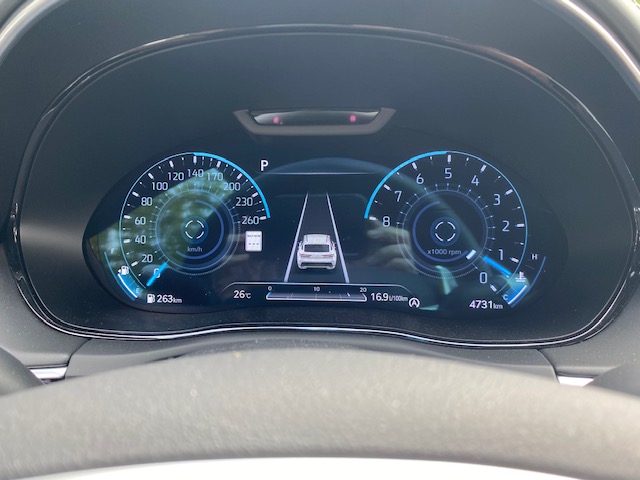
The digital gauge package is crisply marked. A tachometer that spins counter-clockwise is a Genesis eccentricity
The driver faces a configurable digital gauge package that mimics the look of conventional gauges. The GV70 shares an eccentricity, a counter-clockwise tachometer arc, with other Genesis models. A large, tablet style touch screen sits atop the centre of the dashboard. It can be configured to show navigation or infotainment information or both. Below the screen is a slim, full-width accent that contains the dash vents. Genesis designers must have been spending a lot of time on the elliptical machines at their gyms when they designed the GV70’s cabin as that shape is used on the dashboard, door armrests, door handle nacelles and on the console beside the driver. Climate is controlled by a panel with touch-sensitive surfaces for fan speed, air distribution, steering wheel heat and front seat heating and cooling, and rotary dials for temperature adjustment of the dual-zone climate system. A row of piano keys control access to the screens for map, navigation, radio, media and setup. The front of the centre console has a Mazda-style rotary controller accessing the infotainment functions as well as rotary wheels for audio volume and radio station-track selection. Gear selection is via another rotary knob with a “Park” button at its centre. A deep, lidded bin sits beside the infotainment wheel, with cupholders residing alongside the shifter. The bin houses a wireless cellphone charger but is sized perfectly to capture an Ontario Highway 407 transponder, needing kitchen tongs to retrieve. The dashboard and the door panels are swathed in Nappa leather and are visually spare, broken up only by elegant French-stitched seams, but in no way plain. The front doors house bottle holders and some oddments storage. The A and B pillars and the headlining are covered in a luxurious appearing faux suede.
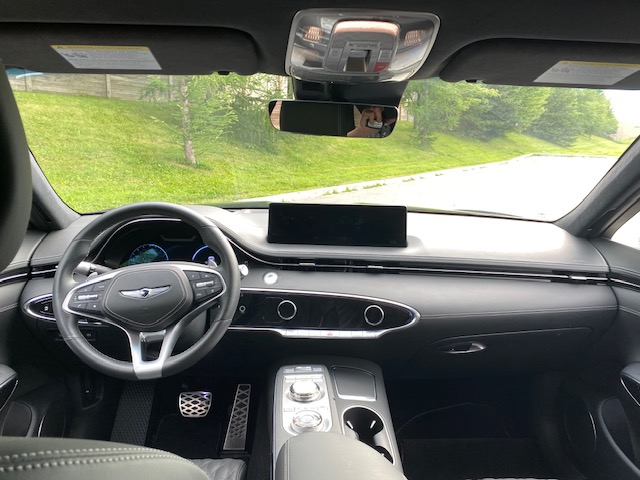
Elliptical cabin styling flourishes clearly demonstrated on the dashboard of the GV70

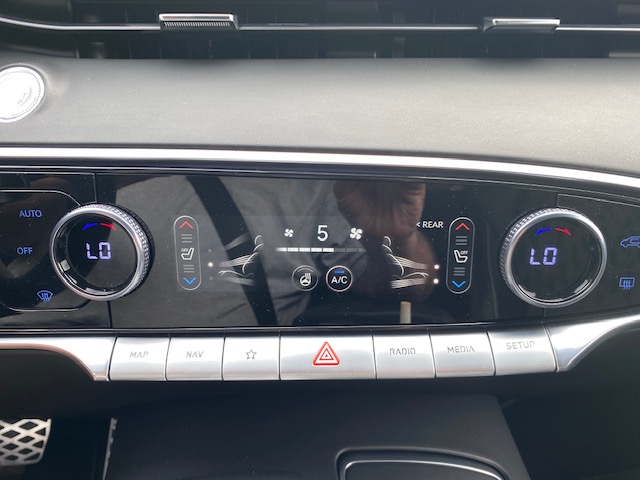
Attractive and logical controls inside the GV70
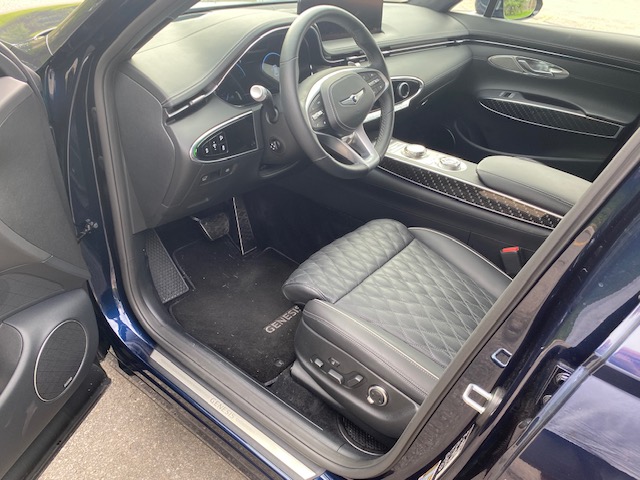
Elegant cabin constructed from premium materials
The seat side bolsters are covered in a plain leather, with the centre panels sewn into a diamond pattern. The seats are generally comfortable but some occupants find the seat bottoms a bit unyielding for true comfort. The front seats feature multiple power adjustments, including bottom cushion extension. There is plenty of room up front and while rear legroom is not generous, it is significantly better than what is offered by the related G70 sedan and more than sufficient for larger adults. The high drive-tunnel as it transits through the rear seat area intrudes on the legroom for a rear centre passenger. Rear seat riders have access to controls for temperature, air distribution, rear seat heat as well as a USB charge point and a 115 volt power point. The cargo area is luxuriously carpeted but not overly spacious, and is a bit on the shallow side.
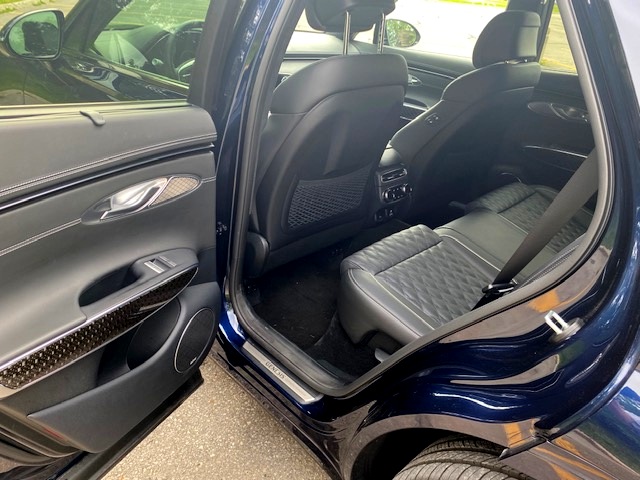
Comfortable rear seat with just enough room for large adults
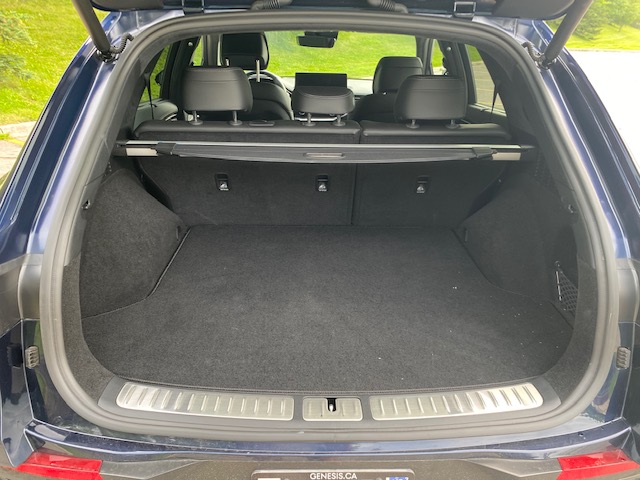
Luxuriously-trimmed cargo bay has adequate, rather than generous space
Performance
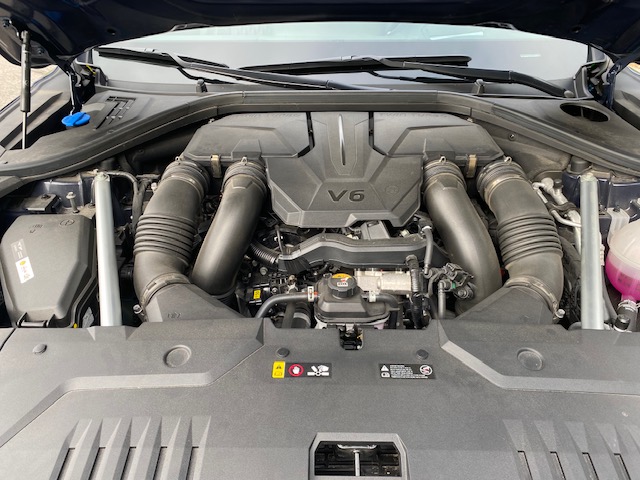
Powerful and silky smooth 3.5L V6 turbo engine
Though not a true performance parameter, the driver’s view framed by the windshield delivers a sense of well-being and great satisfaction to the driver.
Whilethe need for 375 horsepower is debatable, the ability of the GV70’s V6 to turn power into acceleration is never in doubt as performance is vivid and flexible. Unlike many of the vehicles powered by smaller turbo fours which can be woefully unrefined, the V6 turbo in the GV70 is silky smooth at all times except when it is pushed hard, when it emits compelling, precision noises.
Power reaches the wheels via a conventional eight-speed automatic transmission that gets its job done seamlessly most of the times but can clunk discreetly in traffic at low speeds.
Steering is beautifully weighted, precise and even telegraphs a scintilla of road feel up to the driver.
Braking is strong, with good pedal feel and no lost motion in the pedal.
The ride is generally resiliently firm, which is a triumph considering the 255/40/21 tires, more suitable to a sports car than a luxury crossover. Unfortunately, you cannot avoid the unsuitable wheel and tire combination by picking the less-expensive V6 Sport trim, which features the same tires.
The GV70’s air conditioner copes well with sultry Toronto weather and the chilled seats cool occupants quickly. The Lexicon-branded audio system delivers pleasing sounds. Like other Hyundai-Kia products, the dash screen of the GV70 reverts to a “Landscape” view on each start, with the driver needing to press the “Radio” or “Navigation” buttons, which becomes irritating.
Pricing
All GV-70s are equipped with all-wheel drive. Two engines, a 300 horsepower 2.5L turbo four, and a 375 horsepower 3.5L turbo V6, are available. With a dual-panel sunroof, L.E.D. headlights, wireless cellphone charging, leather seating, heated front and rear seats and chilled front seats, power-adjustable front seats and steering wheel, the $57,500 2.5T Advanced model is nicely equipped. Moving up to the 2.5T Advanced Plus adds a Lexicon-branded audio system, a head-up display system, a 360 degree camera array and rear door sunscreens, but is overpriced. The 2.5T Prestige trim includes Nappa leather, alloy pedals, faux suede headliner, rear self-stopping and front seat cushion extenders, but is priced beyond the value of the content. Moving up from the 2.5T Prestige to the 3.5T Sport Plus adds about $3000 in additional equipment plus the V6 engine, for a staggering $12,500. Genesis cars are sold mostly online in Canada, but there are a small number of retail boutiques in major centres in Canada.
Summary
Genesis has had a very slow roll-out in Canada as the company lacked any entries in the dominant crossover market segment. However, since the release of the GV80 and then the GV70, business is picking up. Slow sales have been no reflection on the apparent excellence of the vehicles, which has always been impressive. The fully-optioned GV70 V6 Sport Plus driven by the APA was stylish, swift, near silent, sumptuously appointed and a true luxury vehicle of the first rank. That said, long-term durability is unknown, especially with the four-cylinder turbo that will likely power the majority of GV70s.

Neatly integrated exhaust pipes of the GV70 V6 turbo
